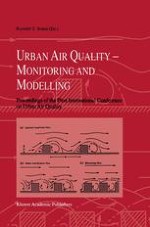1998 | OriginalPaper | Chapter
Multi-Scale Atmospheric Dispersion Modelling by Use of Adaptive Gridding Techniques
Authors : G. Hart, A. Tomlin, J. Smith, M. Berzins
Published in: Urban Air Quality: Monitoring and Modelling
Publisher: Springer Netherlands
Included in: Professional Book Archive
Activate our intelligent search to find suitable subject content or patents.
Select sections of text to find matching patents with Artificial Intelligence. powered by
Select sections of text to find additional relevant content using AI-assisted search. powered by
An accurate prediction of the transport-reaction behaviour of atmospheric chemical species is required to fully understand the impact on the environment of pollution emissions. Elevated levels of secondary pollutants such as ozone in the lower atmosphere can be harmful to the health of both plants and animals, and can cause damage to property present in the urban environment. Detailed models of pollution mechanisms must therefore be developed through comparisons with field measurements to aid the selection of effective abatement policies Such models must satisfy accuracy requirements both in terms of the number of species represented, and the spatial resolution of species profiles. Computational expense often compels current models to sacrifice detail in one of these areas. This paper attempts to address the latter point by presenting an atmospheric transport-reaction modelling strategy based upon a finite volume discretisation of the atmospheric dispersion equation. The source terms within this equation are provided by an appropriate reduced chemical scheme modelling the major species in the boundary layer. Reaction and transport discretisations are solved efficiently via a splitting technique applied at the level of the non-linear equations The solution grid is generated using time dependant adaptive techniques, which provide a finer grid around regions of high spatial error in order to adequately resolve species concentration profiles. The techniques discussed are applied in two dimensions employing emissions from both point and area sources. Preliminary results show that the application of adaptive gridding techniques to atmospheric dynamics modelling can provide more accurately resolved species concentration profiles, accompanied by a reduced CPU time invested in solution Such a model will provide the basis for high resolution studies of the multiple scale interactions between spatially inhomogeneous source patterns in urban and regional environments.
